MC68332GCEH16 Freescale Semiconductor, MC68332GCEH16 Datasheet - Page 168

MC68332GCEH16
Manufacturer Part Number
MC68332GCEH16
Description
IC MCU 32BIT 16MHZ 132-PQFP
Manufacturer
Freescale Semiconductor
Series
M683xxr
Specifications of MC68332GCEH16
Core Processor
CPU32
Core Size
32-Bit
Speed
16MHz
Connectivity
EBI/EMI, SCI, SPI, UART/USART
Peripherals
POR, PWM, WDT
Number Of I /o
15
Program Memory Type
ROMless
Ram Size
2K x 8
Voltage - Supply (vcc/vdd)
4.5 V ~ 5.5 V
Oscillator Type
Internal
Operating Temperature
-40°C ~ 85°C
Package / Case
132-QFP
Cpu Family
68K/M683xx
Device Core
ColdFire
Device Core Size
32b
Frequency (max)
16MHz
Interface Type
QSPI/SCI/UART
Program Memory Size
Not Required
Total Internal Ram Size
2KB
# I/os (max)
15
Number Of Timers - General Purpose
16
Operating Supply Voltage (typ)
5V
Operating Supply Voltage (max)
5.5V
Operating Supply Voltage (min)
4.5V
Instruction Set Architecture
RISC
Operating Temp Range
-40C to 85C
Operating Temperature Classification
Industrial
Mounting
Surface Mount
Pin Count
132
Package Type
PQFP
Controller Family/series
68K
No. Of I/o's
15
Ram Memory Size
2KB
Cpu Speed
16MHz
No. Of Timers
16
Embedded Interface Type
QSPI, SCI, UART
Digital Ic Case Style
PQFP
Rohs Compliant
Yes
Processor Series
M683xx
Core
CPU32
Data Bus Width
32 bit
Data Ram Size
2 KB
Maximum Clock Frequency
16 MHz
Number Of Programmable I/os
15
Number Of Timers
16
Maximum Operating Temperature
+ 85 C
Mounting Style
SMD/SMT
Minimum Operating Temperature
- 40 C
Lead Free Status / RoHS Status
Lead free / RoHS Compliant
Eeprom Size
-
Program Memory Size
-
Data Converters
-
Lead Free Status / Rohs Status
Compliant
Available stocks
Company
Part Number
Manufacturer
Quantity
Price
Company:
Part Number:
MC68332GCEH16
Manufacturer:
Freescale Semiconductor
Quantity:
10 000
- Current page: 168 of 265
- Download datasheet (7Mb)
7.6.2 Channel Control Registers
7.6.2.1 Channel Interrupt Enable and Status Registers
7.6.2.2 Channel Function Select Registers
7.6.2.3 Host Sequence Registers
7.6.2.4 Host Service Registers
7.6.2.5 Channel Priority Registers
7-14
The channel control and status registers enable the TPU to control channel interrupts,
assign time functions to be executed on a specified channel, or select the mode of op-
eration or the type of host service request for the time function specified. Refer to Ta-
ble 7-3.
The channel interrupt enable register (CIER) allows the CPU to enable or disable the
ability of individual TPU channels to request interrupt service. Setting the appropriate
bit in the register enables a channel to make an interrupt service request; clearing a
bit disables the interrupt.
The channel interrupt status register (CISR) contains one interrupt status flag per
channel. Time functions specify via microcode when an interrupt flag is set. Setting a
flag causes the TPU to make an interrupt service request if the corresponding CIER
bit is set and the CIRL field has a nonzero value. To clear a status flag, read CISR,
then write a zero to the appropriate bit. CISR is the only TPU register that can be ac-
cessed on a byte basis.
Encoded 4-bit fields within the channel function select registers specify one of 16 time
functions to be executed on the corresponding channel. Encodings for predefined
functions in the TPU ROM are found in Table 7-3.
The host sequence field selects the mode of operation for the time function selected
on a given channel. The meaning of the host sequence bits depends on the time func-
tion specified. Refer to Table 7-3, which is a summary of the host sequence and host
service request bits for each time function.
The host service request field selects the type of host service request for the time func-
tion selected on a given channel. The meaning of the host service request bits is de-
termined by time function microcode.
A host service request field cleared to %00 signals the host that service is completed
by the microengine on that channel. The host can request service on a channel by writ-
ing the corresponding host service request field to one of three nonzero states. It is a
good practice to monitor the host service request register and wait until the TPU clears
the service request before changing any parameters or issuing a new service request
to the channel.
The channel priority registers (CPR1, CPR2) assign one of three priority levels to a
channel or disable the channel. Table 7-3 indicates the number of time slots guaran-
teed for each channel priority encoding.
Freescale Semiconductor, Inc.
For More Information On This Product,
Go to: www.freescale.com
TIME PROCESSOR UNIT
USER’S MANUAL
MC68332
Related parts for MC68332GCEH16
Image
Part Number
Description
Manufacturer
Datasheet
Request
R
Part Number:
Description:
Manufacturer:
Freescale Semiconductor, Inc
Datasheet:
Part Number:
Description:
Manufacturer:
Freescale Semiconductor, Inc
Datasheet:
Part Number:
Description:
Manufacturer:
Freescale Semiconductor, Inc
Datasheet:
Part Number:
Description:
Manufacturer:
Freescale Semiconductor, Inc
Datasheet:
Part Number:
Description:
Manufacturer:
Freescale Semiconductor, Inc
Datasheet:
Part Number:
Description:
Manufacturer:
Freescale Semiconductor, Inc
Datasheet:
Part Number:
Description:
Manufacturer:
Freescale Semiconductor, Inc
Datasheet:
Part Number:
Description:
Manufacturer:
Freescale Semiconductor, Inc
Datasheet:
Part Number:
Description:
Manufacturer:
Freescale Semiconductor, Inc
Datasheet:
Part Number:
Description:
Manufacturer:
Freescale Semiconductor, Inc
Datasheet:
Part Number:
Description:
Manufacturer:
Freescale Semiconductor, Inc
Datasheet:
Part Number:
Description:
Manufacturer:
Freescale Semiconductor, Inc
Datasheet:
Part Number:
Description:
Manufacturer:
Freescale Semiconductor, Inc
Datasheet:
Part Number:
Description:
Manufacturer:
Freescale Semiconductor, Inc
Datasheet:
Part Number:
Description:
Manufacturer:
Freescale Semiconductor, Inc
Datasheet:











